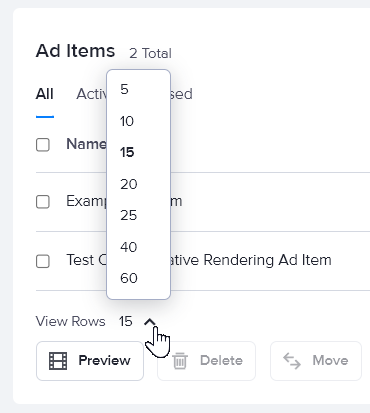Ad item overview
In AdButler, you enter the details of an individual ad into an object called an ad item. Ad items have different types, each corresponding to a different medium or source. This guide will teach you how to create ad items. You will learn:
- About the different types of ad items.
- How to create an ad item directly within a zone.
- How to create an ad item in a campaign.
- About tips for creating ad items.
Ad item types
- Image - For ads made of a static image, which can be a JPEG, PNG, or GIF file. They are delivered using the
imageHTML tag and wrapped in anatag to direct clicks. For more information, read Creating an image ad item.
- HTML5/Rich media - For ads made of an IAB-compatible HTML5 ZIP archive. The archive includes an HTML file and any scripts or media used to display the ad. For more information, read Creating an HTML5/Rich media ad item.
- Custom HTML/Third party tags - For custom ads or scripts. This is also the ad item type that you should select if you want to serve ads from an ad exchange or other external source. For more information, read Creating a custom HTML ad item and Serving third party ad tags.
- VAST ad - For video ads that support the VAST format. AdButler currently supports the VAST 2.0 specification, while VAST 4.2 compatibility is currently in alpha. For more information, read Creating a VAST ad item.
- Native - For native ads. These rely on native ad templates. For more information, read Native ad template overview. You can create native ads that are served through iframes, or ones that are safe to serve directly on the content. However, the latter is compatible only with native zones.
- S2S Connection - For serving ads from other ad networks via a server-to-server connection. We will soon remove this option, because you can now manage demand sources in the Programmatic section. For more information, read Setting up Programmatic Demand (OpenRTB).
How to create an ad item in a zone
- Go to the section of the relevant zone (Your AdButler > Publishers > Your Publisher > Your Zone).
- Click Add Ad Item on the top right of the Ad Items table. You will be prompted to select an ad item type.
- Select the appropriate ad item type. The New Ad Item page will appear.

- Select your preferred serve method. For more information, read Serve Method Options. The rest of the assignment details will appear.
- Fill up the fields as needed. For more information, read Pacing & Schedule, Financial settings, Frequency Capping, and Targeting.
- Click Save. You will be taken back to the zone section, and the ad item you just created will be listed in the table of ad items. You can check what the ad looks like by clicking on its name in the table then clicking Preview.
How to create an ad item in a campaign
- Go to the section of the relevant campaign (Your AdButler > Advertisers > Your Advertiser > Your Campaign).
- Click Add Ad Item on the top right of the Ad Items table. You will be prompted to select an ad item type.
- Select the appropriate ad item type. The new ad item page will appear.
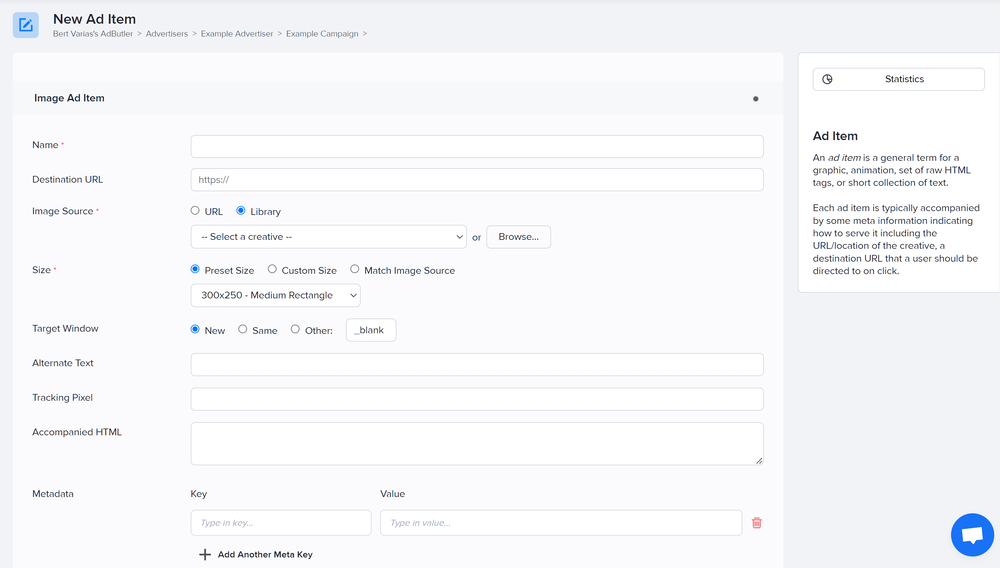
- Fill in the fields as necessary. For more information on weight, read Pacing & schedule.
- Click Save Ad Item. You will be taken back to the campaign section, and the ad item you just created will be listed in the table of ad items.
Tips on creating ad items
Match the sizes - If your ad has an image, the dimensions of both the ad item and the zone to which you will assign the ad item must be the same as the dimensions of that image. You define the dimensions of both ad items and zones when you are creating them, and you can no longer change them after that. You do have the option to set a zone's size to be dynamic, which will allow it to resize to accommodate the dimensions of the ad items that will be assigned to it.
Match the types - Similar to ad items, zones and campaigns also have types. The table below shows their compatibility. When you're assigning a campaign, AdButler will let you choose only from zones that are compatible with the campaign. Similarly, you will not see the option to create a VAST ad item inside a non-VAST zone, and vice-versa.
| Zone | Campaign | Ad Item |
|---|---|---|
| Standard | Standard | Image, HTML5/Rich media, Custom HTML/Third party tag, Native (custom), S2S Connection |
| Standard | Image | |
| Native | Standard | Native (custom), Native (styled) |
| VAST | VAST | VAST |
- Preview your ad item - After creating an ad item, you can check what the ad looks like by clicking on its name in the Ad Items table then clicking Preview.
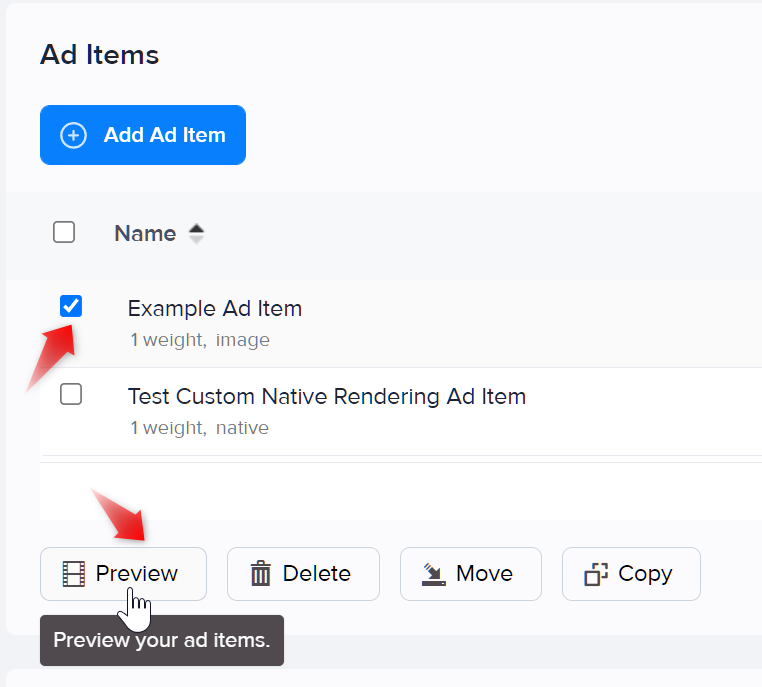
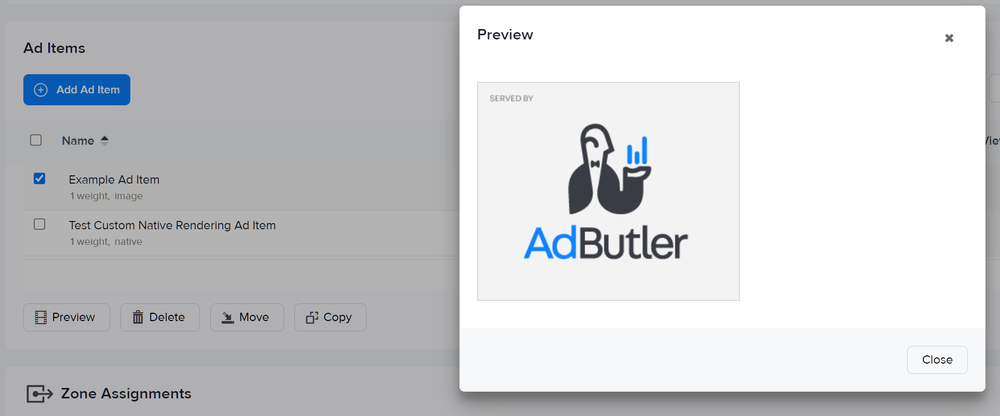
You can also search for and preview ad items on the search bar.
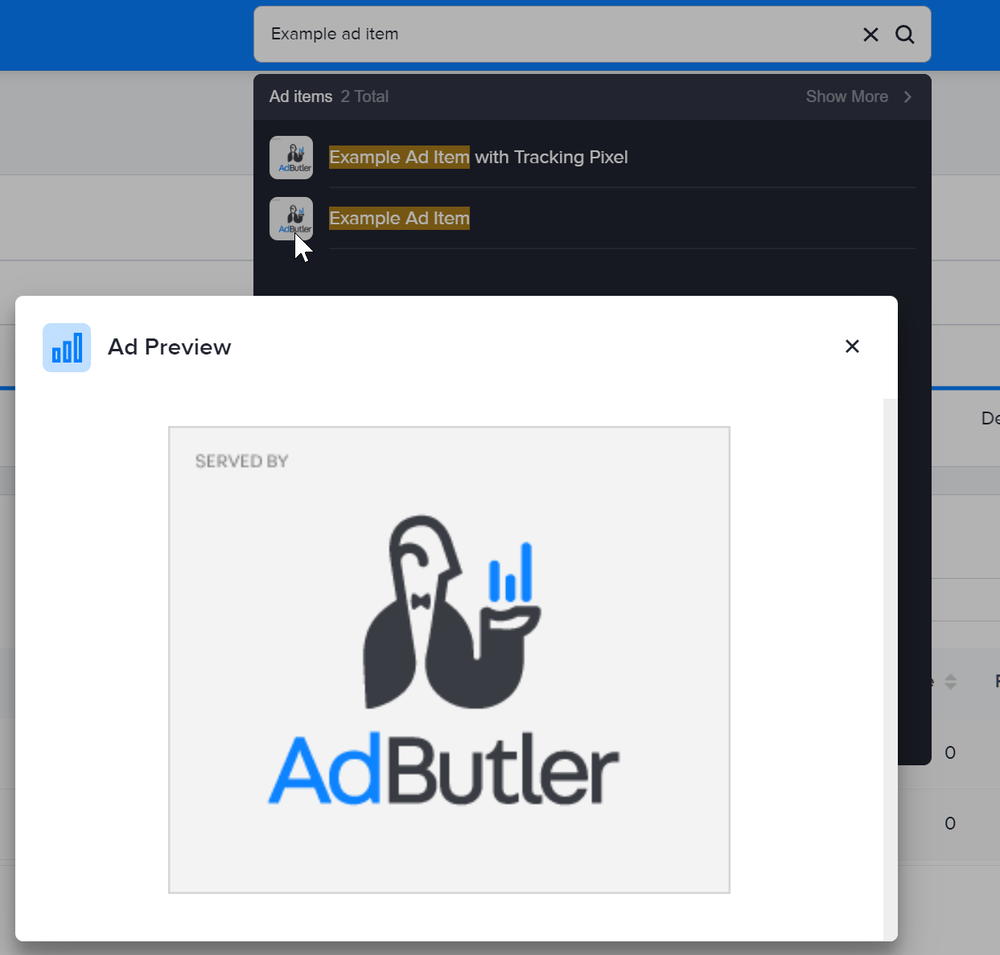
Come up with a clear and consistent naming scheme - Ad item names can have up to 500 characters. As with zones, campaigns, and other elements of your ad serving setup, settle on a descriptive naming scheme for ad items as early as possible and stick to that scheme. This will make it easier to search and identify ad items throughout the AdButler interface as well as in reports.
Use campaigns - A campaign is a group of ad items. Instead of assigning ad items to a zone one by one, you can create the ad items in a campaign, then assign the campaign to the zone. This grouping makes it much easier to assign and unassign multiple ads to multiple zones, log overall advertiser statistics, and run A/B tests on ad creatives. Because of all these benefits, we highly recommend creating ad items in campaigns. The only situation where we can recommend creating an ad item directly within a zone is when you are creating a default or house ad. For more information, read About zones and About campaigns.
Check your ad item stats and properties - You can filter the information shown on both the table of ad items assigned to a campaign. Note that the Status column is always visible.
The default view is Show All Columns:

Click on the dropdown menu on the upper-right of the tables to filter the columns. Select Stats Columns to show only metrics such as eligible impressions, viewable impressions, and clicks:

Finally, select Setup Columns to show information related to the properties of the ad items or zones—the date when an ad item was created, the ad item or zone size, and weight:

- View more ad items at once - By default, the Ad Items table is split into pages that show up to 15 ad items at a time. But you can use the View Rows dropdown menu at the bottom of the table to adjust the maximum number of ad items shown per page.
